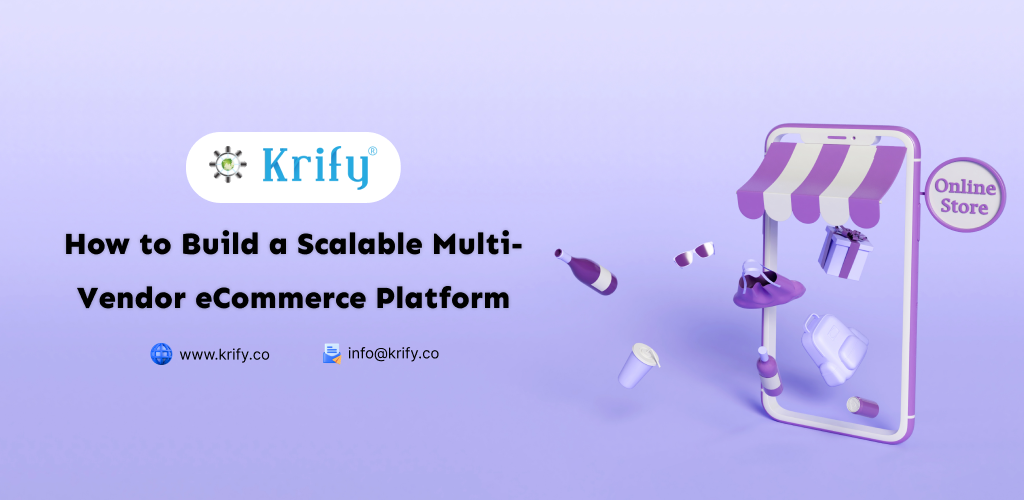Building a scalable multi-vendor eCommerce platform requires meticulous planning, strategic execution, and a deep understanding of what makes an online marketplace successful. While creating a robust platform is essential, focusing on scalability ensures that the site can grow seamlessly with increasing traffic and sellers. Here’s how you can build a scalable, successful multi-vendor eCommerce platform.
1. Define Your Marketplace Vision
Before diving into development, clarify your marketplace vision. Understand who your target sellers and buyers are, what products they’re looking for, and how your platform will stand out. First and foremost, this vision provides a clear direction, helping you decide on essential features and requirements.
2. Choose the Right Technology Stack
Selecting a scalable technology stack is a foundational step. For instance, robust backend languages like Node.js, Django, or Ruby on Rails provide flexibility, while frontend frameworks like React, Angular, or Vue ensure responsive design. Since scalability is the goal, choose cloud-based infrastructure such as AWS, Google Cloud, or Azure, which enables easy expansion without overhauling the infrastructure. Additionally, a reliable database like MongoDB, MySQL, or PostgreSQL supports high data volumes and quick access speeds.
3. Implement a Modular Architecture
Moreover, a modular architecture allows developers to add or update features without affecting the core functionalities of your platform. Modules or microservices operate independently, each serving a specific function, such as order processing, inventory management, or payment handling. This structure allows faster troubleshooting, simplified testing, and easier scaling of individual services.
4. Design an Intuitive Vendor Dashboard
A well-designed vendor dashboard simplifies seller onboarding and empowers vendors to manage their stores independently. Include essential functions like product listing, inventory tracking, and performance analytics. Likewise, enabling customization allows vendors to personalize their storefronts, providing a unique brand experience.
5. Optimize User Experience and User Interface (UX/UI)
The user experience directly impacts how buyers and sellers perceive your platform. An optimized UX/UI promotes easy navigation, fast loading times, and intuitive interactions. Similarly, ensure your platform is mobile-responsive, as many users will access the marketplace through their smartphones. Next, streamline the checkout process to minimize cart abandonment rates, making the entire shopping journey seamless.
6. Integrate Secure Payment Gateways
Another key element is integrating multiple secure payment gateways that cater to different user preferences. Ensure compliance with global payment standards like PCI DSS to protect user data and reduce fraud. Meanwhile, offering a range of payment options, including credit/debit cards, digital wallets, and even cryptocurrency, can improve conversion rates.
7. Enable Advanced Search and Filtering Options
To enhance usability, include a powerful search engine with advanced filtering options. In particular, implement AI-driven search algorithms that predict user intent and provide relevant results. This feature makes the buying process efficient and encourages repeat customers.
8. Prioritize Security and Privacy
Security should be at the forefront of your development. Protect user data with SSL certificates, encrypt sensitive information, and regularly update security protocols. Furthermore, conduct regular vulnerability assessments and implement firewalls to safeguard against cyber threats. Since a breach can significantly harm a platform’s reputation, proactive measures are critical.
9. Implement Analytics for Data-Driven Decisions
Using data analytics, track metrics such as sales trends, user demographics, and vendor performance to make informed decisions. Additionally, leveraging data insights can help identify bottlenecks, guide feature updates, and optimize marketing strategies. As a result, you’ll create a platform that adapts to evolving user needs.
10. Plan for Efficient Customer Support
Beyond the technical aspects, customer support plays a pivotal role in the platform’s success. A multi-vendor eCommerce site involves interacting with both buyers and sellers, making responsive support crucial. On one hand, implementing an AI-driven chatbot can help address common inquiries. On the other hand, live support channels ensure that complex issues receive proper attention.
11. Focus on SEO and Digital Marketing
A strong SEO foundation helps drive traffic organically. Therefore, optimize product pages, use relevant keywords, and structure URLs for search engines. Implementing digital marketing strategies, such as email campaigns and social media marketing, will increase your platform’s visibility and attract both buyers and sellers.
12. Create a Scalable Infrastructure
Building a scalable multi-vendor eCommerce platform requires careful infrastructure planning. From the start, choose scalable cloud hosting, consider load balancing for traffic distribution, and use a Content Delivery Network (CDN) to reduce server load. Otherwise, your platform might struggle to handle sudden traffic surges, negatively impacting user experience.
13. Continuously Monitor and Improve
Launching the platform is just the beginning. Afterward, continuous monitoring and improvement are essential to maintain high standards. Regularly assess performance metrics, update security protocols, and introduce new features based on user feedback.
Conclusion: Choose the Right Partner
Building a scalable multi-vendor eCommerce platform is a multifaceted journey that involves a balanced approach between technology, user experience, and business strategy. In conclusion, partnering with a reliable and experienced technology provider like Krify can make all the difference. With Krify’s expertise, you’ll have a platform designed to scale, adapt, and thrive in a competitive market. So, start planning, build your platform, and get ready to see your vision come to life!
Similar Blogs
Key Features In A Multi-Vendor eCommerce Website Development



